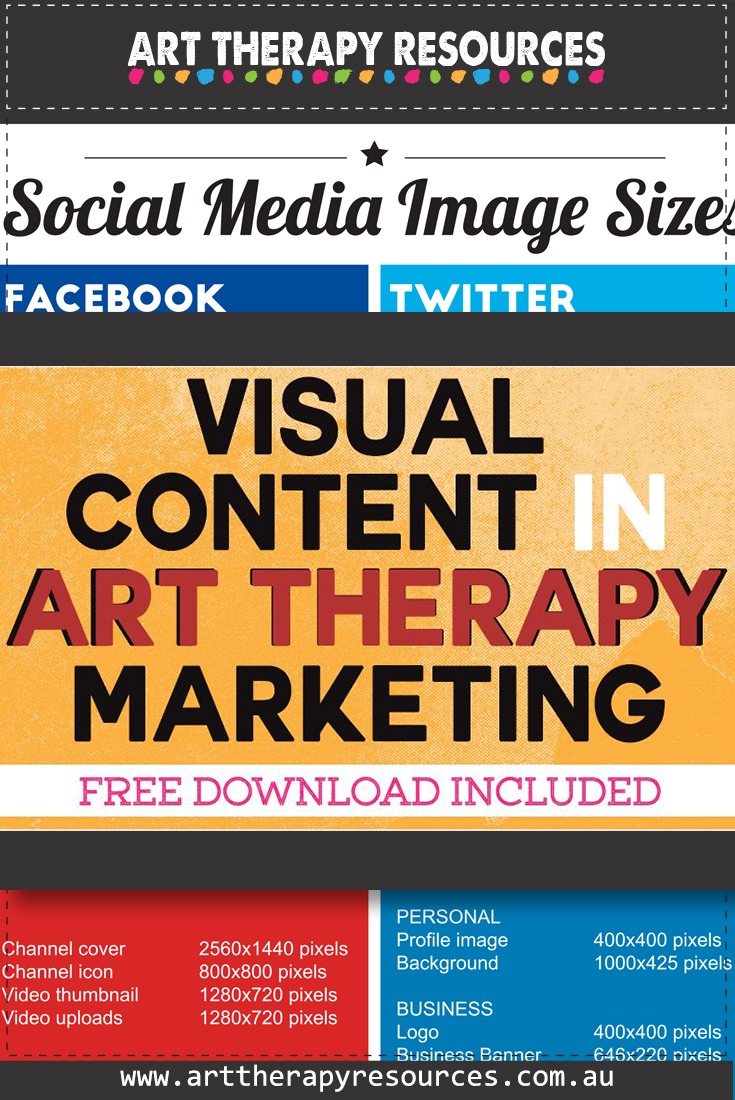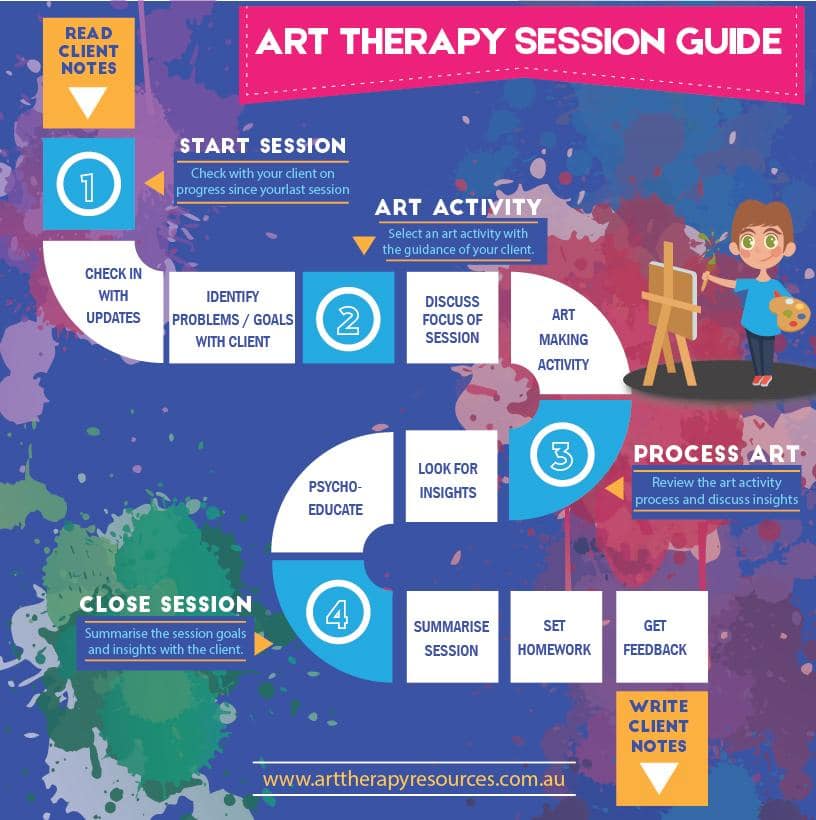THIS POST INCLUDES:
1. Harnessing the Power of Visual Content
2. The Role of Visuals in Marketing
3. Creating Compelling Visual Assets
4. Free Download Social Media Image Size Guide
THE POWER OF VISUAL CONTENT
Marketing is an important aspect of building a successful art therapy private practice, and visual content is an effective tool in conveying the essence of your practice and what you offer your potential clients. Most marketing entails using visual content that serves to capture your audience’s attention. However, utilizing compelling visuals can enhance engagement and communicate the value of art therapy and what you offer clients.
Some of the important ways in which visual images can assist in marketing include:
- Capturing attention – using impactful aesthetics in your images can grab a viewers attention and entire them to read further
- Storytelling – images can depict the way in which your client can see themselves currently and into the future
- Communicating values – images can convey the benefits of art therapy and the values that you hold as a therapist
Visual content is more than a means of capturing attention; it is a dynamic storytelling tool. By creating compelling visuals that encapsulate the essence of art therapy and build a sense of connection, you can pave the way for meaningful engagement with your audience.
SOCIAL MEDIA PLATFORMS
Social media platforms are the usual areas that are designed for visual content sharing and marketing. Art therapists can leverage platforms like Instagram and Pinterest to share visuals that resonate with their target audience. Regular posts, stories, and curated content contribute to building an online presence that reflects the therapist’s expertise and passion for art therapy.
Below are some suggestions on how two popular social media platforms can be utilized for marketing your art therapy practice.
**NOTE: Marketing and sharing content that focuses on therapy on social media platforms requires a degree of discernment in terms of ensuring privacy, confidentiality and not misrepresenting mental health issues and potential treatment. For more information on using social media ethically for a therapy practice, check out our blog post below: Ethical Posting on Your Social Media Pages as a Therapist
1. Instagram: Crafting Visual Narratives
Visual Storytelling:
– Instagram’s visual-centric nature makes it an ideal platform for storytelling through images.
– Craft a visual narrative that provides a glimpse into the process of art therapy. Share images that encapsulate the therapeutic process.
Interactive Features:
– Leverage Instagram’s interactive features such as polls, quizzes, and interactive stories to engage your audience actively.
– Encourage followers to share their thoughts on art therapy or participate in creative challenges.
Behind-the-Scenes Glimpses:
– Humanize your practice by offering behind-the-scenes glimpses into your art therapy sessions (note confidentiality issues).
– Showcasing the creative process and the environment fosters a sense of connection with your audience.
2. Pinterest: Curating Inspirational Boards
Themed Boards:
– Create Pinterest boards that revolve around themes related to art therapy, such as “Expressive Techniques” or “Art for Self-Care.”
– Curate a collection of visuals that inspire and educate your audience on the diverse facets of art therapy.
Resourceful Pins:
– Pin resources, articles, and infographics that align with your art therapy philosophy.
– Position yourself as a valuable resource by curating content that educates and informs your audience.
WEBINARS AND LIVE SESSIONS
Visual engagement extends beyond static images. Art therapists can organize webinars or live sessions where they visually demonstrate art therapy techniques, discuss the benefits, and engage with their audience in real-time. These interactive sessions foster a sense of connection and allow potential clients to experience the therapist’s approach firsthand.
VISUAL GUIDES AND E-BOOKS
Developing visual guides or e-books provides an opportunity to share in-depth insights into art therapy. These resources can include visual representations of therapeutic techniques, case studies, and practical tips. They serve as valuable assets for potential clients seeking comprehensive information about the therapeutic process.
THE ROLE OF VISUALS IN MARKETING
Visuals have the ability to evoke emotions, making them an invaluable asset in conveying the essence of art therapy. Visual images represent an effective form of non-verbal communication that can transcend language barriers. In an industry such as mental health, there is a myriad of terminology that my be confusing and overwhelming to potential clients. In these situations, images can help bridge the gap of providing an aspect that clients can relate to when terminology may be confusing.
SYMBOLIC REPRESENTATION
The use of symbols in visual images in an important aspect of art therapy. So it makes sense to understand that visual images used in marketing hold the same power of connecting with an audience. Visuals act as symbols that can represent complex concepts and emotions. Art therapists can use symbols in their visual content to convey the core principles of art therapy, such as self-expression, healing, and personal growth.
Using images can assist in storytelling by crafting a visual narrative that tells the story of art therapy.
CAPTURING INTEREST
Humans are naturally drawn to visually appealing content. Using aesthetic images in marketing can not only convey a message but also captivate attention, ensuring that your audience remains engaged.
EDUCATION
Art Therapists can create infographics to visually present information about art therapy, its benefits, and the various techniques employed. Using infographics is not only informative, but also more shareable which helps extend the reach of your message.
VISUAL IDENTITY
Crafting a distinct visual identity is essential for art therapists seeking to establish their private practice. Consistent use of visuals, such as logos, color schemes, and design elements, fosters brand recognition. This identity becomes a visual representation of the therapist’s approach, values, and commitment to their clients. Consistency in visuals fosters trust and familiarity among your audience. Visual elements such as logos become visual anchors that reinforce your brand identity in the minds of your audience.
CREATING COMPELLING VISUAL ASSETS
In an therapeutic domain, conveying complex information can be a challenge whereby you need to create engaging content yet also ensure the protection of your potential reader from any manipulative affect of marketing. The therapeutic benefits and developing therapeutic relationship between client and therapist should always be prioritized. Visual communication can have an impact and therefore should be utilized correctly.
INFOGRAPHICS:
The concept of infographics has been around for centuries, but the modern form of infographics, as we recognize them today, has evolved over the past few decades. Today, infographics are an integral part of visual communication, utilized in various fields, including journalism, marketing, education, and more. The evolution of technology and the increasing need to present complex information in a digestible format have played a significant role in the development and widespread use of infographics.
You can see one of the first infographics we created on the Art Therapy Resources website below. The graphic aims to educate both art therapist and clients as to how a typical (not always) session goes. Potential clients can often hold assumptions and fears about experiences they have never had before. This infographic provides an easy to understand visual process of how a typical art therapy session may progress. If you have a different process in your typical art therapy sessions, you can create a similar infographic that explains your process. Of course, it’s always helpful to remind clients that a typical session doesn’t imply rigid rules and that sessions are often guided by the client and their needs.
Infographics function as cognitive load reducers, streamlining information into manageable chunks. This is particularly helpful in the context of art therapy, where conveying the multifaceted aspects of the therapeutic process demands a thoughtful and strategic approach.
MAPPING THE THERAPEUTIC PROCESS
Infographics can serve as visual maps of the therapeutic process, delineating stages of self-discovery, emotional exploration, and transformative growth. This visual narrative aids in demystifying the often intricate journey individuals undertake in art therapy.
An academic approach to infographic design in art therapy necessitates a commitment to evidence-based visuals. Information presented should align with established research and principles, ensuring credibility and reliability in the eyes of both professional peers and the wider audience.
Infographic design in art therapy should adhere to ethical considerations, respecting the confidentiality and sensitivity inherent in therapeutic processes. This scholarly approach emphasizes the responsibility of art therapists in presenting information with the utmost integrity.
SHAREABILITY:
Infographics, designed with a focus on shareability, become assets for dissemination on social media platforms. The shareable nature of these visuals extends the reach of art therapists, fostering a broader understanding of the benefits and processes associated with art therapy.
DESIGNING INFORMATIVE INFOGRAPHICS
Infographics serve as powerful tools for conveying information in a visually appealing and digestible format. Art therapists can create infographics that highlight the benefits of art therapy, the therapeutic process, and other relevant information. These graphics serve as shareable assets, extending the reach of the therapist’s message.
10 WEBSITES WITH FREE IMAGE RESOURCES
If you don’t have your own images to use in your blog posts, you can use images that others have created called stock photography. You cannot freely download images from the internet and assume the original creator has granted you permission to use the image.
By using official stock photography websites you can safely use images based on clearly understood usage permission guidelines. Be sure to read the guidelines for each website you download images from to ensure you are not breaching any requirements.
Some requirements may refer to the type of website you can use the images on and if you have to attribute the original creator of the image or not. Some guidelines will also determine whether the images can only be used in publishing free content (a public blog) vs paid content (used in a paid for e-course).
Below are some useful websites to access free stock photography to use in your blog posts:
Below are some useful websites to access free stock photography to use in your blog posts:
FREE DOWNLOAD: Art Therapy Exercise
SIGN UP below to gain access to our RESOURCE LIBRARY and download the FREE Size Guide for creating Social Media images.

BUILD YOUR ART THERAPY REFERENCE MATERIALS:
Pin this image to your Pinterest board.

SHARE KNOWLEDGE & PASS IT ON:
If you’ve enjoyed this post, please share it on Facebook, Twitter, Pinterest. Thank you!

